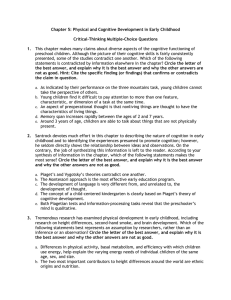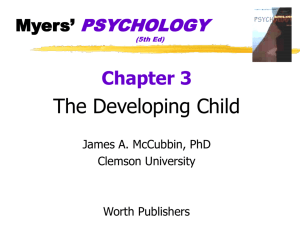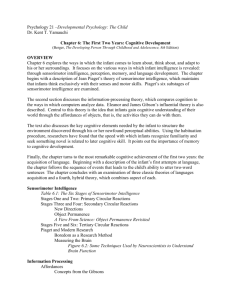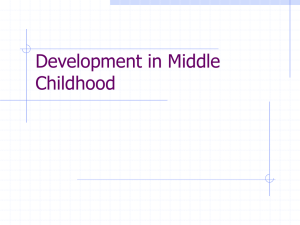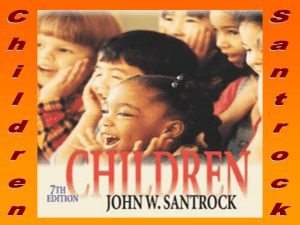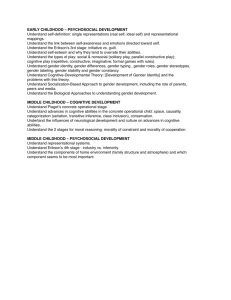Psikologi Anak Pertemuan 4 - 5 Cognition and Language
advertisement
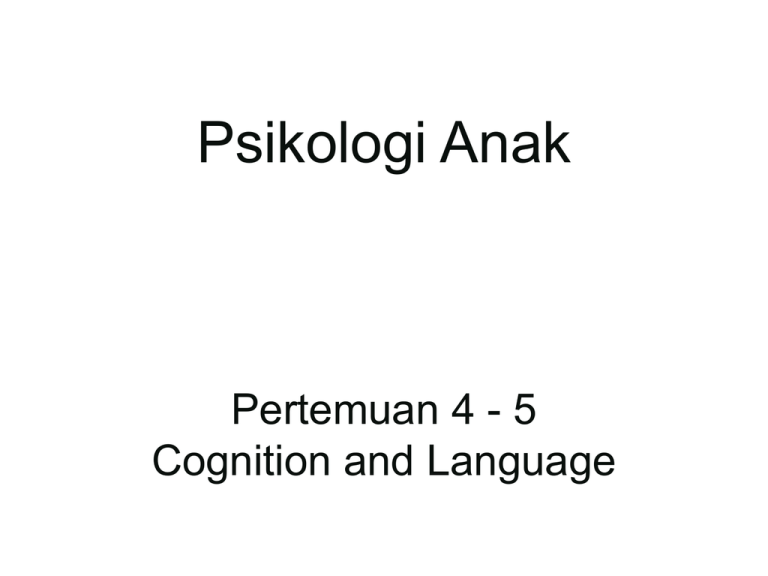
Psikologi Anak Pertemuan 4 - 5 Cognition and Language Cognitive Developmental Approaches : Piaget Piaget observed own 3 children; believed six processes used in constructing knowledge • Schemes – Actions or mental representations that organize knowledge – Behavioral schemes: physical activities characterizing infancy – Mental schemes: cognitive activities develop in childhood • Assimilation — incorporate new information into existing knowledge schemes; operates in very young infants • Accommodation — adjust schemes to fit new information and experiences; operates in very young infants • Organization – Grouping isolated behaviors into a higher order; grouping items into categories • Equilibrium and equilibration – mechanisms proposed to explain how children shift from one stage of thought to the next – Disequilibrium — shift occurs as children experience cognitive conflict – Equilibration — they resolve conflict through assimilation and accommodation, to reach a new balance or equilibrium of thought Stages of Development Piaget’s theory unifies experiences and biology to explain cognitive development • Motivation is internal search for equilibrium • Four stages of development…progressively advanced and qualitatively different • Each stage is discontinuous from and more advanced than another. Vygotsky’s Theory of Cognitive Development • Social contexts; minds are shaped by cultural context in which they live • Tools are provided by society • Children actively construct their knowledge and understanding through social interactions The Zone of Proximal Development • Zone of Proximal Development (ZPD) – Tasks too difficult for children to master alone but that can be mastered with guidance and assistance from more-skilled person Student can work with the assistance of an instructor ZPD Student can work independently • Scaffolding – Changing level of support over course of a teaching session to fit child’s current performance level Vygotsky: Language and Thought • Believed young children use language to plan, guide, and monitor behavior • Language and thought initially develop independently, then merge • Private speech: language of self-regulation – Self talk (3 to 7 years of age) – Inner talk: child’s thoughts Information-Processing Approach Focuses on ways people process information about their world – Manipulate information – Monitor it – Create strategies to deal with it – Effectiveness involves attention, memory, thinking Simplified model of information processing Mechanisms of Change Encoding Mechanism by which information gets into memory Automaticity Ability to process information with little or no effort Strategy Construction Discovering new procedure for processing information Metacognition Cognition about cognition, or “knowing about knowing” Attention focusing mental resources Sustained Attention State of readiness to detect and respond to small changes occurring at random times in environment; also called vigilance Selective Attention Focusing on specific aspect of experience that is relevant while ignoring others Divided Attention Concentrating on more than one activity at a time Infancy • Newborns can detect contours and fixate • 4-month-olds have selective attention • Processes closely linked to attention – Habituation: decreased responsiveness to stimulus after repeated presentations – Dishabituation: recovery of a habituated response after change in stimulation Childhood and adolescence • Most research on selective attention • Cognitive control of attention shows changes – Preschooler attends to external salient stimuli – Child of 6 to 7 attentive to relevant information – Ability to shift attention increases with age; allows for more complex task involvement Memory retention of information over time Process of memory Infancy • First Memories – Rovee-Collier infant memory experiments • Implicit memory: memory without conscious recollection; skills and routine done automatically • Explicit memory: conscious memory of facts and experiences; doesn’t appear until after 6 months • Infantile Amnesia – Adults recall little or none of first three years – Also called childhood amnesia – Due to immaturity of prefrontal lobes in brain; play important role in memory of events Childhood Memory • Considerable improvement after infancy • Short-term memory — memory span for up to 15 to 30 seconds without rehearsal • Working memory — kind of mental workbench for manipulating and assembling information – Make decisions, solve problems – Comprehend written and spoken language • Long-term memory — relatively permanent and unlimited type of memory Working Memory Model Activities to improve information processing • Rehearsal — repetition • Organizing — trying to group related information • Imagery — creating mental images • Elaboration — engaging in more extensive processing of information Thinking Manipulating and transforming information in memory • Reason, reflect, evaluate to make decisions • Concepts — categories that group things – Perceptual categorization: as young as 3 mos – Categorization increases in second year; infants differentiate more • Critical thinking: grasping deeper meaning of ideas Involves: – – – – – – Ask what, how, and why Examine facts and determine evidence Recognize one or more explanations exist Compare various answers, select the best Evaluate before accepting as truth Speculate beyond what is known Metacognition Knowledge about when and where to use particular strategies • Theory of mind—thoughts about how mental processes work Child’s theory of mind – Ages 2 to 3 — begin to understand • • • Perceptions Desires Emotions – Age 5 — realization of false beliefs – Middle and late childhood — mind seen as active constructor of knowledge • Metamemory—knowledge about memory – Limited in children – Preschoolers have • Inflated opinion of memories • Little appreciation for importance of memory cues – Understanding of memory abilities and skill in evaluating performance improves considerably by 11 to 12 years of age – Adolescents more likely than children to manage and monitor thinking Intelligence thinking skills and the ability to solve problems and to adapt and learn from everyday experiences • Theories of Multiple Intelligences – Factor approaches • Spearman’s two factors theory • Thurstone’s 7 primary mental abilities: verbal comprehension, number ability, word fluency, spatial visualization, associative memory, reasoning, and perceptual speed – Gardner’s theory of multiple intelligence: verbal, mathematical, spatial, bodily kinesthetic, musical, interpersonal, intrapersonal, naturalistic – Sternberg’s triarchic theory : analytical, creative, and practical • Emotional intelligence Intelligence • Genetic and environmental influence • Development of intelligence – Test of infant intelligence: Gesell’s and Bayley scales of infant development, Fagan test of infant intelligence • Stability and change in intelligence through adolescence Language a form of communication that is based on a system of symbols • Infinite Generativity – The ability to produce an endless number of meaningful sentences using a finite set of words and rules. • Language’s rule systems – – – – – Phonology Morphology Syntax Semantics Pragmatics How Language Develops – Infancy • Babbling and Other Vocalizations – The purpose of early communications is to attract attention from caregivers and others in the environment. • The first year sequence of sounds and gestures: crying, cooing, babbling, gestures • Recognizing Language Sounds – Long before they learn words, infants make fine distinctions among the sounds of language. – From birth to about 6 months of age, infants recognize when sounds change despite the language that is being spoken. – By about 6 months of age, infants have started to specialize in the speech sounds of their native language. How Language Develops – Infancy • First Words – First understanding of words between 8 to 12 months. – Spoken vocabulary begins when the infant utters its first word, usually at about 10 to 15 months of age. – The average 18-month-old speaks about 50 words; children speak about 200 words by 2 years of age. – Overextension is the tendency to apply a word to objects that are not related to, or are inappropriate for, the word’s meaning; underextension is the tendency to apply a word too narrowly. • Two-Word Utterances – By the time children are 18 to 24 months of age, they usually utter two-word statements. – Telegraphic speech is the use of short and precise words without grammatical markers to communicate. How Language Develops – Early Childhood • Between ages 2 and 3 years, children quickly move into three-, four-, and five-word combinations, and transition from simple sentences/single ideas to complex sentences. • As children go through their early childhood years, their grasp of the rule systems that govern language increases. How Language Develops – Early Childhood • Understanding syntax • Advances in Semantics – As children move beyond the two-word stage, their knowledge of meanings also rapidly advances. – The speaking vocabulary of a 6-year-old ranges from 8,000 to 14,000 words. • Advances in Pragmatics – Displacement: At about 3 years of age children improve their ability to talk about things that are not physically present. – At about 4 years of age, children develop a remarkable sensitivity to the needs of others in conversation, and begin to use the article “the”; by 5 they sometimes use the article “a.” – Around age 4 or 5, they change their speech style to suit the situation. How Language Develops – Middle and late childhood • Vocabulary and Grammar – Children become less tied to the actions and perceptual dimensions associated with words; more analytical in their approach to the words. – Metalinguistic awareness, the knowledge of language that allows children “to think about their language, understand what words How Language Develops – Middle and late childhood • Reading – Children who enter elementary school with a small vocabulary are at risk for developing reading problems. – Reading skills develop over many years and require a prior ability to use language to talk about things that are not present; learning what a word is; and learning how to recognize and talk about sounds. – Alphabetic principle: Letters represent sounds in the language. • Whole-language vs. Basic-skills-and-phonetics approach How Language Develops • Bilingualism – Bilingualism, the ability to speak two languages, has a positive effect on children's cognitive development. • Bilingual children perform better than their singlelanguage peers on tests of control of attention, concept formation, analytical reasoning, cognitive flexibility, and cognitive complexity (Bialystok, 1999, 2001). • They also have better formal language skills. • Learning a second language, and learning correct pronunciation of the language, is easier for children than for adolescents or adults. Biological Influences • Linguist Noam Chomsky (1957) believes humans are biologically prewired to learn language at a certain time and in a certain way. • Children are prepared by nature with the ability to detect the sounds of language and to detect and follow language rules. • Brain – Aphasia: A language disorder, resulting from brain damage, that involves a loss of the ability to use words. – Broca’s area: An area of the brain’s left frontal lobe that directs the muscle movements involved in speech production. – Wernicke’s area: An area of the temporal lobe in the brain’s left hemisphere that is involved in language comprehension. Biological and Environmental Influences • Is There a Critical Period for Learning Language? – Critical Period • A fixed time period in which certain experiences can have a long-lasting effect on development; beyond this period, learning is difficult or impossible. • Young children’s proficiency in language does not seem to involve a biologically salient critical period that older children and adults have passed. Environmental Influences • The Behavioral View – Language represents chains of responses acquired through reinforcement. – Language is a complex, learned skill. – Criticisms: Children learn the syntax of their native language even if they aren’t reinforced; there is an extensive orderliness of language not explained by the behaviorist view. • Interaction with people: The support and involvement of caregivers and teachers facilitate a child’s language learning. • The quantity of talk that parents direct to their children is linked with the child’s vocabulary growth. – The quantity of talk is linked to the family’s socioeconomic status. • Child-Directed Speech – The kind of speech often used by adults to talk to babies and young children—in a higher pitch than normal and with simple words and sentences. Biological and Environmental Influences • Strategies to enhance the child’s acquisition of language include: – Recasting: Rephrasing something the child has said. – Expanding: Restating, in a linguistically sophisticated form, something the child has said. – Labeling: Identifying the names of objects. • Encouragement, not drill and practice, is the key to language development.

